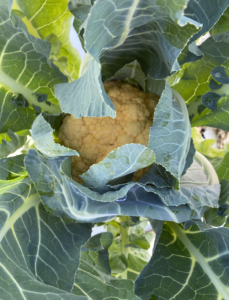Cauliflower
Filter by:
Cauliflower Suppliers
Gardener's Supply is proud to be employee-owned. We are gardeners ourselves and have earned our customers' trust by providing high-quality products, expert information, and friendly, personalized service.
We understand the products we sell because we use them in our own gardens. Regular product training sessions and a gardening certification program for our staff help us provide the best service and support in the business.
Cauliflower Growing Guides
- University of Minnesota - Growing cauliflower in home gardens | UMN Extension
- Cornell University - Explore Cornell - Home Gardening - Vegetable Growing Guides - Growing Guide
- Garden Savvy - How to Grow Cauliflower
- Michigan State University - How to Grow Cauliflower - MSU Extension
- Penn State - Cauliflower | Diseases and Pests, Description, Uses, Propagation
Cauliflower was originally cultivated from wild cabbage, like other members of the Brassica family of vegetables. These are known sometimes as “brassicas” and sometimes as “cole crops.” They include cabbage itself, broccoli, Brussels sprouts, and kale, among many others. Originally cultivated in Cyprus, cauliflower was first imported and grown in Europe in the 1500s, in France.

Cauliflower was originally cultivated from wild cabbage, like other members of the Brassica family of vegetables. These are known sometimes as “brassicas” and sometimes as “cole crops.” They include cabbage itself, broccoli, Brussels sprouts, and kale, among many others. Originally cultivated in Cyprus, cauliflower was first imported and grown in Europe in the 1500s, in France. The French name chouxfleur, from which the English name is derived, actually means “cabbage flower.” Cauliflower is highly nutritious and is used in a myriad of ways. It can be served raw, pickled, roasted, baked, and served marinated, or even grilled. It’s a popular meat substitute for vegetarians too!
 There are literally hundreds of varieties of cauliflower. There are four basic common types. The first is white cauliflower, which is the most common and recognizable type of cauliflower. Snow Crown and White Corona are the best known of the white varieties. Next is green cauliflower, which is clearly a cauliflower from its shape, but is the same color as broccoli, and generally has a sweeter taste. The Romanesco cauliflower, which is also known as the broccoflower, was initially crossed with broccoli when it was first cultivated and can be recognized by its sharply pointed florets. Other green varieties are just like the white ones, except for color and taste.
There are literally hundreds of varieties of cauliflower. There are four basic common types. The first is white cauliflower, which is the most common and recognizable type of cauliflower. Snow Crown and White Corona are the best known of the white varieties. Next is green cauliflower, which is clearly a cauliflower from its shape, but is the same color as broccoli, and generally has a sweeter taste. The Romanesco cauliflower, which is also known as the broccoflower, was initially crossed with broccoli when it was first cultivated and can be recognized by its sharply pointed florets. Other green varieties are just like the white ones, except for color and taste.
Purple cauliflowers are very easy to see in the garden and are a nice change in appearance in recipes. They have a slightly milder flavor than white cauliflowers. The last of the basic varieties are orange (or yellow) cauliflowers, which also have a sweeter and milder flavor. Within these groups are many other sub-varieties, and a few very different appearing cultivars. One of these is the Fioretto cauliflower, which has smaller individual florets of varying color, not all closely packed like most other varieties.
Cauliflower is packed with nutrition, high in vitamin C, various B vitamins, and also vitamin K. Orange cauliflowers like the “Cheddar cauliflower” (named for its color, not its taste!) are much higher in beta-carotene than other varieties. The purple varieties are higher in anti-oxidants.
- Cauliflower (Brassica oleracea var. botrytis)
- Annual (biennial)
- Full sun (partial shade in warmer climates)
- Soil should be slightly acidic (6.0 to 7.0 ph)
- Rich, well-drained, loamy soil, with good compost
- Spring planting should start about four weeks before the last frost summer planting for fall harvest should start in mid-summer
1/2” deep
Thin to 18 inches apart when four to six weeks old
- Start seeds indoors 6 weeks before transplanting outside
Container sized holes or a little larger, about 24 inches apart
- Containers:
Single plants in 18″ deep, and 18″ wide pots
When planting cauliflower, it’s important to be very aware of the general temperature and climate. This is a cool weather plant. Keeping the growing plant cool is more important for this type of Brassica than many others. The ideal temperature is between 60 and 65 degrees when maturing. Higher than 70 can cause the florets to develop wrong. Too much heat can cause them to bolt or to not fully develop. The length of time it takes to fully mature varies a lot, from 50 to 100 days, depending on the variety. For direct seeding in your garden, many gardeners recommend planting in mid-summer for a fall harvest, to provide the best temperature ranges for this plant. The Romanesco variety is a good variety for fall.
A few varieties, such as the Snow Crown, mature quickly (in 50 to 60 days) and are more resistant to heat. Starting the seeds indoors 6 weeks before your last frost date gives some more leeway with this, and allows some time for the plants to mature before the high heat of summer begins. For best results, reference the Hortisketch growing calendar and your growing zone.
Seeds should be planted 1/2” deep, in good, rich, well-drained soil. If starting from seedlings, when planting into the garden, they should also be spaced 24 inches apart. Rows should each be about three feet apart. Keep them watered; an inch or two of water each week is best, so ensure to water the plants every week if it has not rained that much.
Container planting is another option, which has the advantage of giving a bit more control over the conditions for this temperamental vegetable. The pot needs to be big enough, twelve inches deep, and eighteen inches wide. A plastic container with very good drainage is a good option, since it doesn’t soak up the plant’s water as much as a terra cotta planter, and it’s light enough to move around if needed. Cauliflower does not grow roots as deep as other cole crops, but they do need their space. Starting a seedling and transplanting it into the container is more reliable than starting the seed directly in the container. A hybrid seedling like the Cheddar cauliflower is a good choice for a container crop. Use good quality soil, and ensure that it’s watered frequently, but don’t water unless the soil is dry. Fertilizing every 4-6 weeks will ensure that it has good nutrition.
One thing to be aware of with cauliflowers, for both garden and container varieties, is what’s called “blanching.” This is the process of carefully wrapping the leaves up around the head, to keep the sun from turning the heads greener and more bitter than they need to be. Some types have naturally curling leaves that protect the head. For those that don’t, when the heads are a few inches wide, just pull the larger leaves up around the head, and secure them completely around it with tape or string.
Don’t plant tomatoes, peas, or strawberries near the cauliflower. These are pretty much the opposite of companion plants, they will cause problems by using up nutrients the cauliflower needs. Beans and onions are both great companion plants for cauliflower, but not for each other. If you plant beans nearby OR onions nearby, they will help with nutrition, repelling pests, and attracting good insects. Don’t plant beans and onions together though. Celery, on the other hand, is pretty much an ideal companion plant. It specifically repels the white cabbage butterfly, the adult version of the pest caterpillar known as the cabbage worm.
Other pests to look out for include cabbage loopers, snails and slugs, flea beetles, and aphids. Plucking insects by hand, spraying with soapy water or using a neem oil spray, and the use of diatomaceous earth scattered around the base of the plant are all good treatments for many pests. Some diseases to be aware of are Alternaria leaf blight, blackleg, black rot, and black spot, all shown by discoloration on the leaves. Good sunlight and watering at ground level is a good preventative for all of these. Remove the affected leaves, and dispose of them in the trash – do not compost!. One more disease, clubroot, affects many brassicas, including cauliflower. Plants that don’t develop fully, and have blighted leaves may suffer from this fungus. The roots will also swell and “club up.” To prevent this, try and keep the soil from getting too acidic, adding lime if necessary. If this happens, there is no remedy, pull the plant out completely and dispose of it away from the garden.
When fully mature, the head will be firm and tight, and 6 inches across or a little more, for most varieties. Don’t let them get past the harvest stage! Cut the heads off the main plant carefully, leaving the larger leaves wrapped around it. Smaller heads that are opening up should also be harvested. If you have had any problems with cabbage worms, soak the head in salty water for at least 15 minutes or so, this will expel any worms. Otherwise, just clean by rinsing off, and refrigerate for up to a week!









